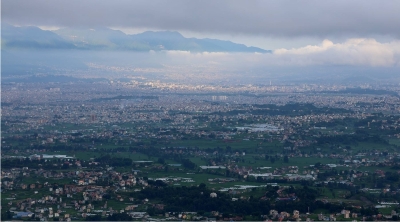Almost 23pc of food available in the market is below standard
Government inspection of various food products available in the market have time and again revealed they do not comply with legal standards. Against the backdrop of ineffective government regulations, unscrupulous traders in the market have been compromising on food quality supplied to the market, while putting the health of consumers at risk. Sujan Dhungana of The Himalayan Times spoke to Sanjeev Kumar Karn, director general of the Department of Food Technology and Quality Control to know about the country’s food market and other quality issues. Excerpts:
What is your evaluation of the quality of food items currently available in the market?
The market of food — along with its demand and consumption pattern — has changed drastically in the past few years. There are so many food products available in the market today that some items slip under our radar. Nevertheless, a majority of available food products in the marker are as per the legal standards set by the government, while a few have not complied with legal norms. The quality of food products in Nepal is guided by the Food Act, 1967 and Food Rules, 1970. These policies have set minimum standards that available food products should meet in Nepal. The foods that comply with standards set by these policies are termed ‘good’ while those not complying with legal standards have been categorised as either ‘low-standard’ or ‘unhygienic’. ‘Low standard’ food does not contain the exact amount of ingredients as per the set standard. However, such foods do not immediately affect human health. On the other hand, consumption of ‘unhygienic’ food directly affects human health. We have basically divided available food into three broad types on the basis of the risk they pose to human health. They are ‘high-risk’, ‘medium-risk’ and ‘low-risk’. Our studies have shown that up to 23 per cent of available food products in Nepal are of low standards. Our challenge now is to bring down the availability of low standard foods to a minimum level. For this, we need to increase our capacity to inspect and regulate the market. Similarly, we also need to increase awareness among people.
Among other consumables, government inspections have found high quality problems in water and milk. What is DoFTQC doing to ensure quality of these products?
It is true that quality problems are high in water, milk and oil in the domestic market compared to other food products. These foods fall under the ‘high-risk’ food category of the government. High-risk foods require higher attention of the government and regular inspections. Similarly, the government should also adopt comparatively stronger licensing processes for these foods. These foods require dedicated policies and laws. Moreover, high-risk food should mandatorily adopt the good manufacturing practice (GMP) standards of the World Health Organisation (WHO). The inspection modality for aforementioned three types of foods will also be different to each other. Through strong policies, we need to make the manufacturer of high-risk foods highly responsible towards the quality of their products. Meanwhile, DoFTQC has already prepared dedicated directives for water and milk. Similarly, we are preparing directives for oil. These directives have clearly listed out the quality standards that these foods should meet, including the quality of raw materials to be used, and processing and manufacturing system. For example, the guideline on milk incorporates quality measures that farmers should adopt while producing milk, standards that chilling centres should follow, quality issues that dairies should follow while processing milk and fundamentals that dairies should meet while supplying milk to the market.
Anomalies, especially in food quality, are often high in the market during festive season. How does the department plan to ensure that the market is not flooded with substandard food products in the upcoming festive season?
Along with consumption, the supply of various foods also surge during the festive season. In fact, the consumption pattern of Nepalis during festive season is different compared to normal times. As food business spikes during the festive season, chances of anomalies also increase during the time. The department is planning to run festive-market-focused market monitoring activities in coordination with various government agencies, basically in city areas where the demand and consumption of food during festivals are higher. Currently, we are developing a modality of inspection targeting the upcoming Dashain, Tihar and Chhath. During this time, we plan to focus our inspection on foods whose consumption is higher during festivals.
Traders have been claiming that the government’s inspections are targeted only at domestic products and businesses, while imported products and their standards are overlooked. Is this true?
We have two systems in practice to control the quality of foods in the market — one focused on domestic products and the other on imported goods. We have separate ‘work procedure’ for both of these quality-check systems and will soon introduce separate guidelines to regulate these systems. It is not that the department has overlooked foreign products and their standards. Currently, any imported food product should mandatorily take pre-import permit from the government to enter the domestic market. The pre-import permit incorporates different standards that imported food products should meet in Nepal. Moreover, the pre-import permit seeks the quality certification of the product from the host nation, which is issued by food safety regulatory body there. This ensures that foods being imported in the market are up to the set standard. Similarly, we have urged different customs offices to verify whether or not each imported food item meets the pre-import permit standards. We have also set up quarantine offices at different checkpoints, where the quality and standard of imported food products are verified. Currently, we have only four quarantine offices of DoFTQC but we plan to set up eight more such offices in different checkpoints soon. However, it is true that we need to strengthen our capacity to control both import and supply of low standard food products in the market. Meanwhile, we are also expanding the network of DoFTQC across the country. This will ensure that food market is regulated across the country. Likewise, we are also continuously upgrading our laboratories in every province. We are also reforming the central food laboratory in Kathmandu to National Food and Feed Reference Lab to maintain uniformity in the results of different laboratories under DoFTQC.
The current government policies related to food regulations are said to be outdated and not very contextual. Do you agree?
Yes, it’s true. Food products in Nepali market are regulated basically by Food Act and Food Rules, both of which were prepared considering country’s market about 50 years ago. However, fact is the market size, pattern and consumption trend of food have drastically changed over last few decades. Similarly, nature of foods available back then and now has changed a lot. Today, we have dedicated food products in market for infants, children, adults, females, elderly, athletes and sick people. Thus, quality assurance system and measures adopted by our Food Act and Food Rules do not match today’s market and foods. Thus, our policies have to be reformed and made market-friendly. Meanwhile, we are preparing to bring a new Food Safety and Standardisation Act soon by incorporating the current nature of the market, food products and consumption pattern of people.






